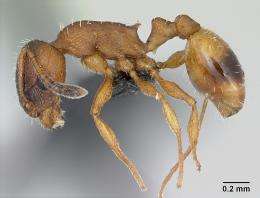February 16, 2010 report
Ants die alone, protecting their nest mates from infection

(PhysOrg.com) -- Scientists studying ants have discovered that when they are seriously ill they voluntarily go away from the nest to die, which reduces the chances of them passing their infection to nest mates.
Scientists Jurgen Heinze and Bartosz Walter, from the University of Regensburg, Germany were interested in reports in ants, cats, dogs, elephants, and occasionally in humans, that some dying individuals would leave their homes to die away from their companions. Since the phenomenon happens only occasionally, it is difficult to study quantitatively.
Heinze and Walter reared a colony of ants (Temnothorax unifasciatus) in the laboratory, and then exposed them to spores of a parasitic fungus (Metarhizium anisopliae) that kills ants. They discovered that most infected worker ants deserted the nest in the hours or even days before they died and made their way to a distant foraging area, where they died alone, away from the other workers. They left voluntarily, and were not forcibly removed by other worker ants.
It is known that fungi can manipulate behavior. For example, ants infected by a cordyceps fungus will climb to the top of a stem, rather like zombies, and will die there, allowing the fungus spores leaving the body to spread more widely from the higher vantage point. To eliminate this possibility, the researchers exposed other ants to 95% CO2, which considerably reduces their life expectancy. They found that affected ants also left the nest to die, even though they had not been infected by the fungus. In observing ant colonies, they also saw the same behavior in ants dying from unknown causes. This shows that ants actively removed themselves from the nest voluntarily and broke off social interactions with the other ants regardless of the cause of their imminent death.
The act of removing themselves from the nest when death seems imminent may reduce the chance of infection spreading to other ants. Similar behaviors are seen in other social insects. The bumblebee, for example, is also known to leave the hive when it is infected by fly larvae, but in this case the bee is moving into a colder temperature, which would reduce the lifespan of the larvae and might save its own life, as well as lowering the chance of infection to other members of the hive.
The findings of the study are reported in the journal Current Biology.
More information: Moribund Ants Leave Their Nests to Die in Social Isolation, Jürgen Heinze, Bartosz Walter, Current Biology, Volume 20, Issue 3, 249-252, 28 January 2010. DOI:10.1016/j.cub.2009.12.031
© 2010 PhysOrg.com

















